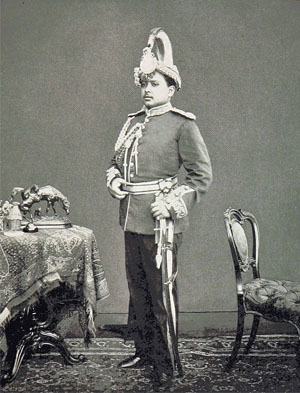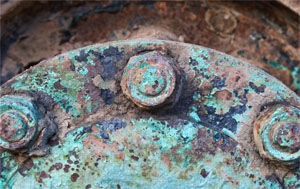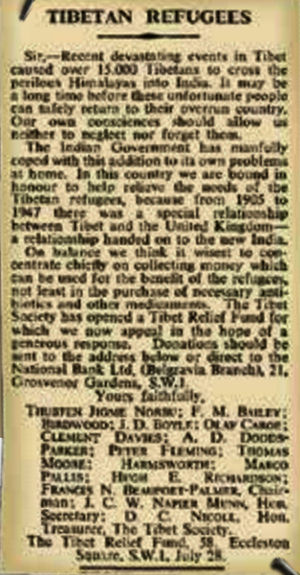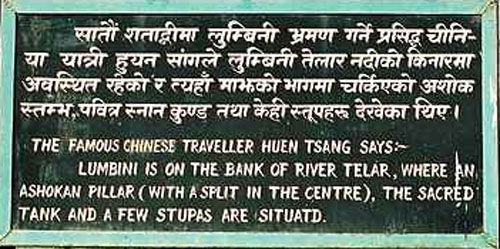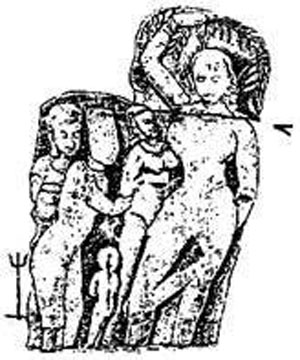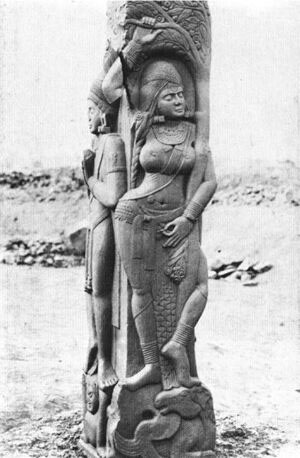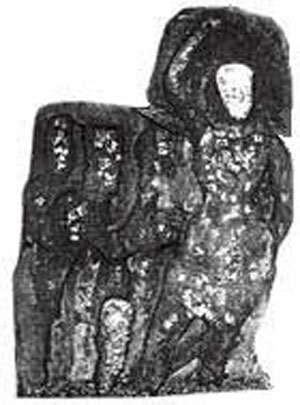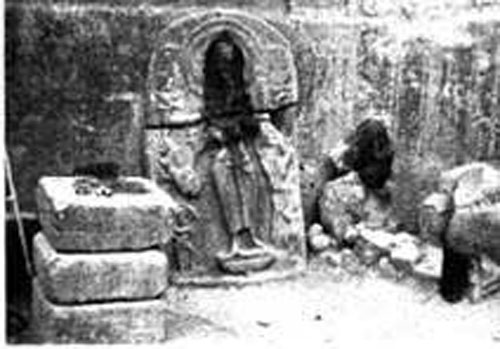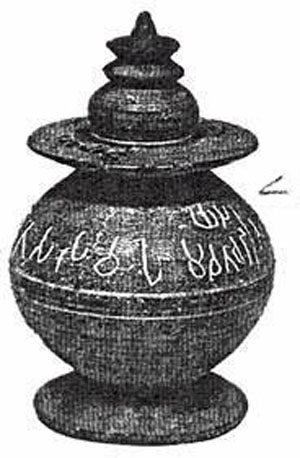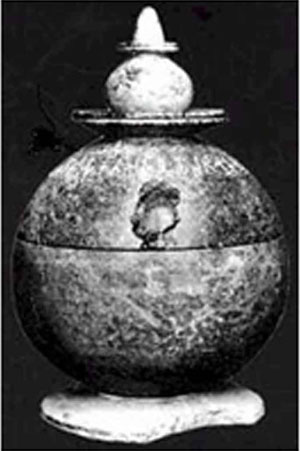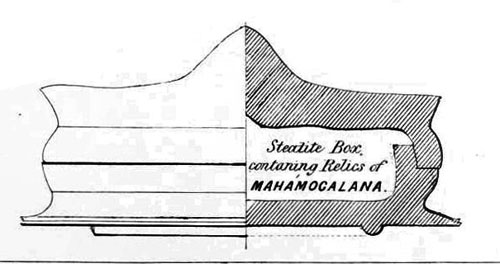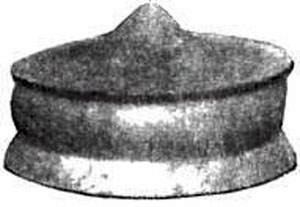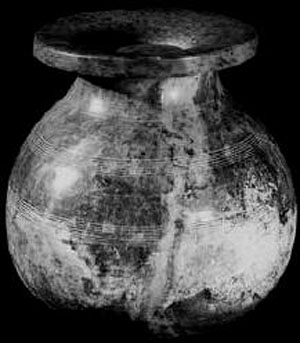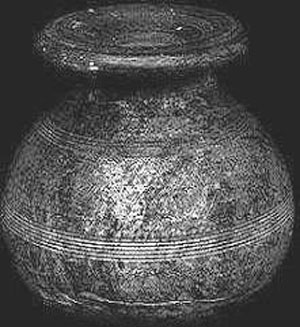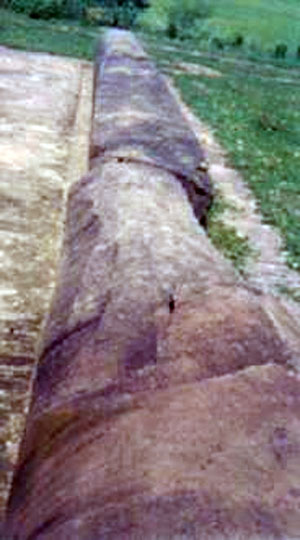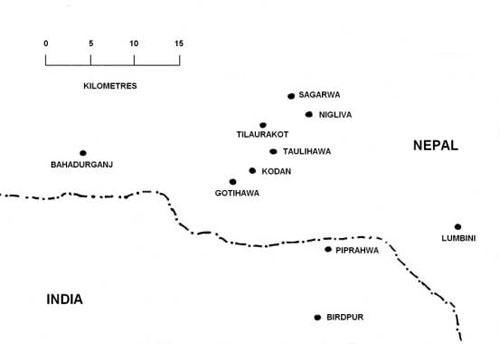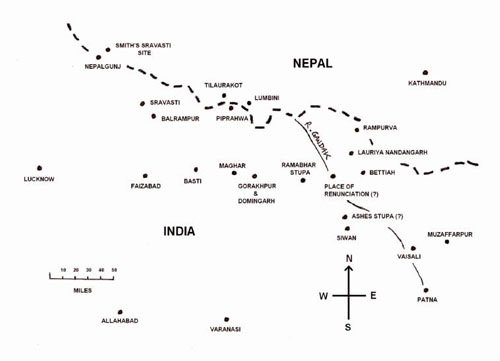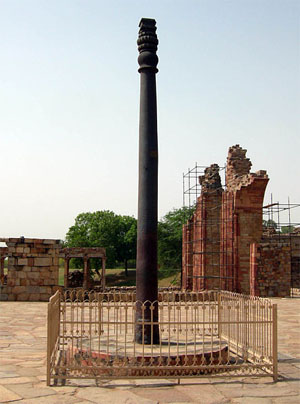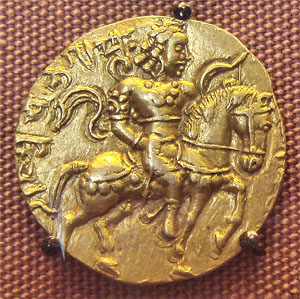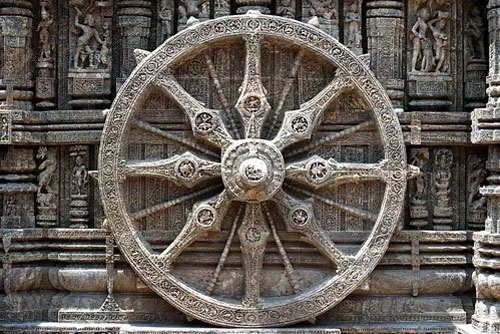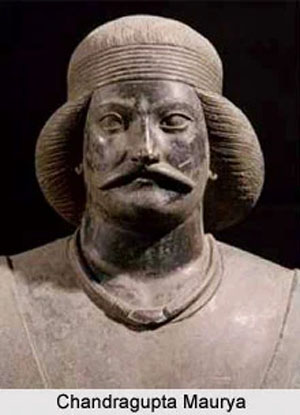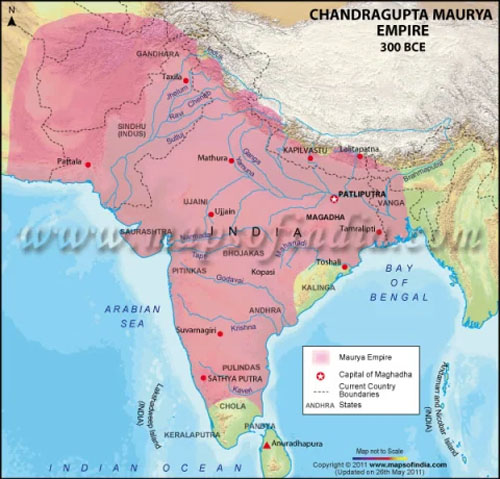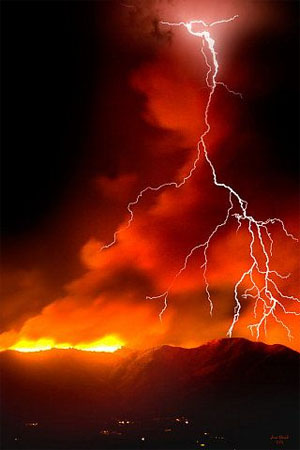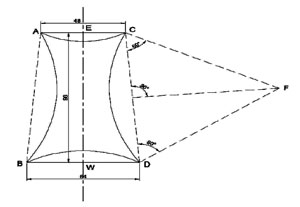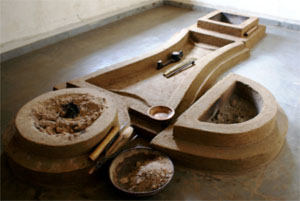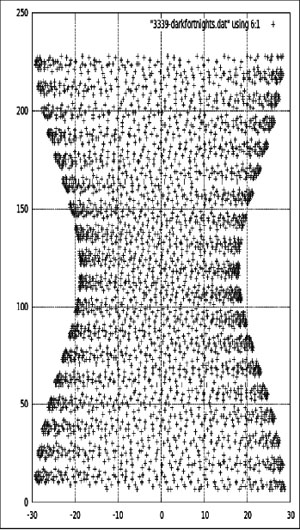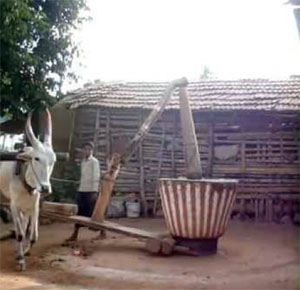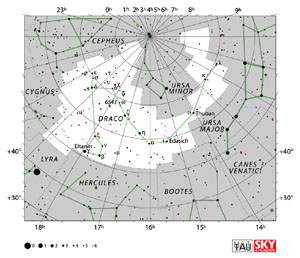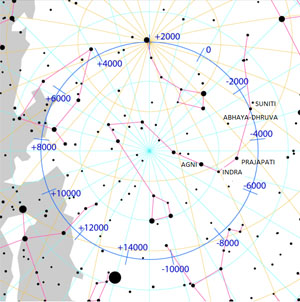Lumbini On Trial: The Untold Story
Lumbini Is An Astonishing Fraud Begun in 1896
by T. A. Phelps
© T. A. Phelps
2008
NOTICE: THIS WORK MAY BE PROTECTED BY COPYRIGHT
YOU ARE REQUIRED TO READ THE COPYRIGHT NOTICE AT THIS LINK BEFORE YOU READ THE FOLLOWING WORK, THAT IS AVAILABLE SOLELY FOR PRIVATE STUDY, SCHOLARSHIP OR RESEARCH PURSUANT TO 17 U.S.C. SECTION 107 AND 108. IN THE EVENT THAT THE LIBRARY DETERMINES THAT UNLAWFUL COPYING OF THIS WORK HAS OCCURRED, THE LIBRARY HAS THE RIGHT TO BLOCK THE I.P. ADDRESS AT WHICH THE UNLAWFUL COPYING APPEARED TO HAVE OCCURRED. THANK YOU FOR RESPECTING THE RIGHTS OF COPYRIGHT OWNERS.
Highlights:
There are compelling reasons for believing that the site of Lumbini is an extraordinary hoax. The details of its discovery in 1896 reveal a tale of deception and intrigue, which is now told for the first time...
[T]he finds made at Piprahwa, in Basti District, Uttar Pradesh...that of Tilaurakot and its surrounding sites, in the Western Tarai of Nepal... neither of these claims can be considered as acceptable, and ... equal doubt attaches to the present site of Lumbini also...
[A]ny attempt to assess the reliability of the present identifications should begin by taking a close look at the circumstances surrounding their discovery. Chief among the participants in those events... was the notorious figure of Dr Alois Anton Fuhrer, a German archaeologist employed by the (British) Government of the North-Western Provinces and Oudh between 1885-98, and co-discoverer of the present Lumbini site.
Modern Indologists, while aware of Fuhrer’s unsavoury reputation, have neglected to conduct any really close scrutiny of his activities, fondly believing that these have long since been satisfactorily catalogued and assessed, and that Fuhrer may be safely consigned to oblivion in consequence. Unfortunately, this is far from being the case. Fuhrer, in fact, drove a coach and horses through critical areas of Indological research, and his deceptions continue to have far-reaching consequences for world history to this day. He was a prolific plagiarist and forger (who worked, alarmingly, on the first two volumes of the Epigraphia Indica) and I have good reason to believe that his deceptions were sometimes condoned, even exploited, by the Government of the day, for imperial reasons of their own...
Fuhrer’s first venture into fraudulent activity appears to have occurred in 1892, when he copied inscriptions from Buhler’s articles on Sanchi and Mathura, reworked them, and wrote the results into the report of his own excavations at the site of Ramnagar. This wholesale deception appears to have passed completely unnoticed during this period, including, apparently, by Buhler himself, with whom Fuhrer was then in correspondence. He also incised Brahmi inscriptions on to stone exhibits in the Lucknow Museum at this time...
Fuhrer found a pillar near the Nepalese village of Nigliva. An Asokan inscription was reportedly discovered by Fuhrer on a broken piece of this pillar, the main shaft of which lay close by...
The inscription referred to Asoka’s enlargement of the stupa of the ‘previous Buddha’, Konagamana, which according to Fuhrer was situated close by, ‘amidst vast brick ruins stretching far away in the direction of the southern gate of Kapilavastu’. Fuhrer gave extensive details of this ancient and impressive structure, declaring that it was ‘undoubtedly one of the oldest Buddhist monuments in India’, and stating that ‘on all sides of this interesting monument are ruined monasteries, fallen columns, and broken sculptures’.
All this was pure moonshine however, as later surveys soon revealed. The stupa didn’t exist, and it was found that Fuhrer had copied its elaborate details (including those ‘ruined monasteries, fallen columns, and broken sculptures’) from Alexander Cunningham’s book ‘Bhilsa Topes’...two years before Fuhrer’s visit -- Hoey had commissioned the local Governor, Khadga Shamsher, to take rubbings of the pillar inscriptions in this area, ‘but these were not of Asoka lettering’. Fuhrer also lied when he claimed that the inscribed portion of this pillar was ‘resting on a masonry foundation’, the precise measurements of which he also gave; this didn’t exist either, this broken piece being merely stuck into the ground at the site. Indeed, Hoey declared that Fuhrer had ‘lied and lied on a grand scale’ concerning his alleged Nepalese discoveries, adding that ‘one is appalled at the audacity of invention here displayed’.
Finally, the Divyavadana describes how Asoka was conducted to Lumbini for the first time by his spiritual preceptor, Upagupta, who pointed out to the king the spot where the Buddha was born. Though the Lumbini pillar inscription states that this visit occurred during the twentieth year of Asoka’s reign, the nearby Nigliva inscription states that Asoka ‘increased for the second time the stupa of Buddha Konagamana’ when he had been reigning for only fourteen years. This is absurd. Why would Asoka decide to enlarge the Konagamana stupa -- and for the second time -- six years before he had even set foot in the Lumbini area?...
(1896) found Fuhrer back in Nepal once more, this time ‘to explore the whole neighbourhood of Taulihawa as far as Bhagvanpur, where there is said to exist another Asoka Edict pillar’... V. A. Smith had obtained rubbings from it ‘a dozen years’ earlier, and had found only ‘mediaeval scribblings’ on its exposed portion at that time.
The site was supposedly called ‘Rummindei’, this being considered to be a later variant of the name ‘Lumbini’...it appears that neither the Nepalese officials nor the hill-men called it 'Rummindei'...
The Indian Survey map of 1915 lists the spot as ‘Roman-devi’; it should be noted that another ‘Roman-devi’ exists about 30 miles WSW of the Nepalese site, near the Indian town of Chandapar. Today, the site is situated in the ‘Rupandehi District’ of Nepal...
The subsequent excavations around the pillar reportedly disclosed an Asokan inscription about a metre below ground, and level with the top of a surrounding brick enclosure...
Fuhrer had supposedly left the site just before any excavations had begun, leaving the Governor and his ‘sappers’ to do the digging. In his official letter on the matter, Fuhrer stated that he had advised the Governor ‘that an inscription would be found if a search was made below the surface of the mound’ on which the pillar was situated. Since there was no previous historical reference to such an inscription, one wonders at Fuhrer’s remarkable prescience on this occasion...
The appearance of this inscription in 1896 marked its first recorded appearance in history...
In Watters’ book ‘On Yuan Chwang’s Travels in India’ (prepared from an unpublished manuscript after his death) the following statement is found with reference to the Lumbini site:‘Yuan-chuang, as we have seen, mentions a stone pillar, but he does not say anything about an inscription on it. The Fang-chih, however, tells us that the pillar recorded the circumstances of Buddha's birth’.
The Fang-chih -– a shortened version of Yuan-chuang’s account -- does nothing of the sort...
It was a posthumous interpolation into Watters’ original text by its editors, Rhys Davids, Bushell, and Smith...
Fuhrer was later found to have fraudulently laid claim to the discovery of about twenty relic-caskets at sites close to Lumbini, which allegedly bore Asokan, and even pre-Asokan inscriptions. One of these items supposedly contained a tooth-relic of the Buddha, which Fuhrer illicitly exchanged for gifts with a Burmese monk, U Ma (the correspondence between these two makes for lamentable reading, with Fuhrer exploiting U Ma’s gullibility quite unmercifully). Following an official enquiry into the matter, this tooth-relic was found to be ‘apparently that of a horse’ : Fuhrer had explained its large size to an indignant U Ma by pointing out that according to ‘your sacred writings’ the Buddha was nearly thirty feet in height!
According to Fuhrer, this ‘Buddhadanta’ had been found by a villager inside a ruined brick stupa near Tilaurakot, and was ‘enshrined in a bronze casket, bearing the following inscription in Maurya characters: “This sacred tooth-relic of Lord Buddha (is) the gift of Upagupta” (the mentor of Asoka). Having obligingly parted with the relic, the villager had refused to part with the inscribed casket itself ‘which is still in his possession’. Fuhrer reported finding this bogus Asokan inscription during the selfsame visit which saw the discovery of the Asokan inscription at Lumbini. Moreover, according to Fuhrer, the Lumbini inscription included words which were supposedly spoken by Upagupta whilst showing Asoka the Buddha’s birth-spot: ‘It would almost appear as if Asoka had engraved on this pillar the identical words which Upagupta uttered at this place’, he tells us, all wide-eyed. However, what with a bogus Upagupta quote on the casket, an Upagupta quote on the pillar, and Fuhrer’s keen taste for forging Brahmi inscriptions, we may here recall that he had fraudulently incised Brahmi inscriptions on to stone four years earlier (see ‘Fuhrer's Early Years’). And indeed, this pillar inscription ‘appeared almost as if freshly cut’ when Rhys Davids examined it in 1900, a view echoed by Professors N. Dutt and K. D. Bajpai, who noted that ‘it appears as if the inscription has been very recently incised’ when they examined it fifty years later. W. C. [William Claxton] Peppe observed that ‘the rain falling on this pillar must have trickled over these letters and it is marvellous how well they are preserved; they stand out boldly as if they had been cut today and show no signs of the effects of climate; not a portion of the inscription is even stained’.
Inscriptions on other Asokan pillars located at sites associated with the Buddha’s life and ministry -- Sarnath and Kosambi, for example -- contain no references to their Buddhist associations, as this pillar so conspicuously -- and twice -- does; and no other inscription makes reference to any erection of a particular pillar by Asoka (as this one does) either...
There is an additional mystery here. As noted above, Fuhrer had supposedly left the site just before the inscription was unearthed. Yet he had travelled up from Lucknow, crossed the Nepalese Tarai to Nigliva by elephant -– a difficult and laborious undertaking -- and then been further redirected to the ‘Rummindei’ site, where he had been officially appointed to superintend the excavations. The existing accounts state that having finally arrived at the site, Fuhrer identified the pillar as Asokan, assured Khadga Shamsher that an Asokan inscription would be found after further excavation, and then, astonishingly, left before the inscription was exposed. This is frankly unbelievable...V. A. Smith stated that a nearby landowner, Duncan Ricketts, ‘had the good fortune to be present while the inscription was being unearthed. Dr Fuhrer arrived a little later’. But Smith’s statement ignores Fuhrer’s earlier presence at the site; and since the accounts which were furnished by Fuhrer and Khadga Shamsher make no reference to Ricketts anyway, one assumes that Fuhrer had alerted him to these excavations after this mysterious departure (Ricketts lived just a few miles away). So what’s to stop Fuhrer from forging the inscription, reinterring the excavated soil (a common archaeological practice) and then notifying Ricketts of events at the site, an action which would have served to remove any subsequent awkward questions on the matter? Only this scenario, it seems to me, can explain Fuhrer’s sudden absence at this critical moment - by far the most important in his entire archaeological career - and it is evident that skulduggery was very much at work here.
Fuhrer also refers to a ‘pilgrim's mark’ on the upper part of this pillar, and whilst providing no photograph of it, still less any details of its language, script, or content, he dates it at around 700 AD. He states that since this item was visible above ground whilst the Asokan inscription lay hidden beneath the soil, this somehow explains Yuan-chuang’s failure to notice the latter during his visit to Lumbini around 635 AD. However, since there is no such ‘pilgrim's mark’ on this pillar anyway -- this was yet another Fuhrer lie –- it is evident that this was merely another clumsy attempt by Fuhrer (as with the phony Nigliva stupa) to add credence to this Asokan inscription also...
There are, moreover, serious epigraphical problems with the pillar inscription itself...
More damaging still, however, is the presence of the term ‘Sakyamuni’ in this inscription. Simply put, it shouldn’t be there. ‘Sakyamuni’ is a later, Sanskritised form of this term, and thus has no place in an allegedly Asokan Brahmi inscription...There would thus appear to be no epigraphical support for the presence of ‘Sakyamuni’ in this Asokan Brahmi inscription, and I shall charge that this exposes it as yet another Fuhrer forgery...
In 1994, I photographed an official notice at the present Lumbini site (see Fig. 1 ) the text of which ran as follows:‘The famous Chinese traveller Hiuen Tsang says:- “Lumbini is on the bank of the River Telar where an Asokan pillar (with a split in the centre), the Mayadevi Temple, the Sacred Tank, and a few stupas are situated”.’
Yuan-chuang, alas, makes no such statement, and like Fa-Hsien, his account makes no mention whatsoever of any ‘Mayadevi Temple’ at Lumbini. He is also, as we have seen, quite specific about the stupas at the site, and of their significance, and his account mentions only a ‘little river of oil’ and not the River Telar (which runs about a kilometre away from the present site anyway). As for the ‘Mayadevi Temple’ itself, I can find nothing to connect this structure with Lumbini, let alone with anything Buddhist. Neither pilgrim makes any reference to it as I have noted, and the present item is an entirely modern affair anyway, beneath which lay the remains of an earlier structure exposed by P.C. Mukherji in 1899. The ornately-carved bricks which formed part of this earlier edifice were identical to those found in structures at the nearby Sivaite sites of Sagarwa and Kodan, these being dated by Debala Mitra at ‘not earlier than the eighth century AD’.
Similarly, the sandstone image in this ‘temple’ (see Fig. 2) supposedly of Mayadevi giving birth to the Buddha, appears equally dubious on a close examination of its origins. This bas-relief, in which the figures are so defaced as to be unrecognisable (see Fig. 5) formed part of the remains of various broken statues which Mukherji found during his visit to the site in 1899. These items consisted of Hindu deities such as Varahi, Durga, Parvati, Ganesh, etc -- nothing Buddhist -- and it is noted that the supposed image of Mayadevi bears a striking resemblance to figures of yakshis and devatas also...all of these items -- the so-called ‘Mayadevi’ figure included -- were associated with the earlier structure found by Mukherji, and are therefore of mediaeval Hindu provenance. There is thus nothing Buddhist about the ‘Mayadevi Temple’ at all, and it is not a temple either.
In January 1898, W. C. [William Claxton] Peppe, manager of the Birdpur Estate in north-eastern Basti District, U. P., announced the discovery of soapstone caskets and jewellery inside a stupa near Piprahwa (see map) a small village on this estate. An inscription on one of these caskets appeared to indicate that bone relics, supposedly found with these items, were those of the Buddha. Since this inscription also referred to the Buddha’s Sakyan kinsmen, these relics were thus generally considered to be those which were accorded to the Sakyas of Kapilavastu, following the Buddha’s cremation...
• Peppe had been in contact with Fuhrer just before announcing the Piprahwa discovery (Fuhrer was then excavating nearby, at the Nepalese site of Sagarwa: see map). Immediately following Peppe's announcement, it was discovered that Fuhrer had been conducting a steady trade in bogus relics of the Buddha with a Burmese monk, U Ma. Among these items -– and a year before the alleged Piprahwa finds -- Fuhrer had sent U Ma a soapstone relic-casket containing fraudulent Buddha-relics of the Sakyas of Kapilavastu, together with a bogus Asokan inscription, these deceptions thus duplicating, at an earlier date, Peppe’s supposedly unique finds. Fuhrer was also found to have falsely laid claim to the discovery of seventeen inscribed, pre-Asokan Sakyan caskets at Sagarwa, his report even listing the names of seventeen ‘Sakya heroes’ which were allegedly inscribed upon these caskets. The inscribed Piprahwa casket was also considered to be both Sakyan and pre-Asokan at this time -- though its characters have since been shown to be typically Asokan -- and no other Sakyan caskets have been discovered either before or since this date.
• The bone relics themselves, purportedly 2500 years old, ‘might have been picked up a few days ago’ according to Peppe, whilst a molar tooth found among these items (and retained by Peppe) has recently been found to be that of a pig. The eminent archaeologist, Theodor Bloch, declared of the Piprahwa stupa that ‘one may be permitted to maintain some doubts in regard to the theory that the latter monument contained the relic share of the Buddha received by the Sakyas. The bones found at that place, which have been presented to the King of Siam, and which I saw in Calcutta, according to my opinion were not human bones at all’....
• The caskets appear to be identical to caskets found in Cunningham’s book ‘Bhilsa Topes’ (see Figs. 7-12) a source also used by Fuhrer for his Nigliva deceptions. A photograph of the ‘rear’ of the inscribed Piprahwa casket, taken in situ at Piprahwa in 1898 (and never published thereafter) discloses that a large sherd was missing from the base of the vessel at this time (see Fig. 8). Having closely examined this casket in 1994, I noted that a piece had since been inserted into this broken base, and that this had been ‘nibbled’ in a clumsy attempt to get this piece to fit. The photograph also reveals a curious feature on the upper aspect of the casket; this, I discovered, was a piece of sealing-wax (since transferred to the inside) which had been applied to prevent a large crack from running further. From all this, it is evident that this casket had been badly damaged from the start, a fact not mentioned in any published report. But is it likely, one is prompted to ask, that this damaged casket, supposedly containing the Buddha’s relics, would have been deposited inside the stupa anyway? Or is this the broken casket, ‘similar in shape to those found below’, which was reportedly found near the summit of the stupa, and which had vanished without trace thereafter? This casket -– also damaged -- was the first of the alleged Piprahwa finds; so did Peppe take it to Fuhrer, and did Fuhrer then forge the inscription on it? Is the Piprahwa inscription simply another Fuhrer forgery? As Assistant Editor on the Epigraphia Indica, Fuhrer would certainly have had the necessary expertise to do this, quite apart from his close association with the great epigraphist, Georg Buhler (who may have unwittingly provided Fuhrer with the necessary details, according to the existing accounts).
• On his return to the U.K., Peppe was contacted by the London Buddhist Society, and agreed to answer readers’ questions on his finds. Shortly afterwards however, the Society was notified that Peppe had suddenly been taken seriously ill, and was therefore unable to answer any questions as proposed. The Society declared the matter to be ‘in abeyance’ in consequence; but Peppe died six years later, leaving all such questions still unanswered.
-- Lumbini On Trial: The Untold Story. Lumbini Is An Astonishing Fraud Begun in 1896, by T. A. Phelps
Contents:
• Introduction
• Fuhrer’s Early Years
• The Nigliva Discovery
• The Lumbini Discovery
• The Lumbini Pillar Inscription
• The Location of The Lumbini Pillar
• The Mayadevi Temple
• The Piprahwa Discoveries
• The Kapilavastu of the Chinese Pilgrims
• Will the Real Kapilavastu Please Stand Up?
• Lumbini
• The Rama Stupa
• From Rama to Kusinara
• Kusinara
• Postcript
• References
• Illustrations
Introduction
There are compelling reasons for believing that the site of Lumbini is an extraordinary hoax. The details of its discovery in 1896 reveal a tale of deception and intrigue, which is now told for the first time.
At present, controversy continues to surround the location of Kapilavastu, the Buddha’s native town, with both India and Nepal promoting bids for this historically significant site. The Indian claim is based on the finds made at Piprahwa, in Basti District, Uttar Pradesh; the Nepalese, by that of Tilaurakot and its surrounding sites, in the Western Tarai of Nepal. It is my intention in this paper, however, to demonstrate that neither of these claims can be considered as acceptable, and to show that equal doubt attaches to the present site of Lumbini also. I further propose to nominate what I consider to be the correct locations for these and other major Buddhist sites, and to give detailed evidence in support of these proposals.
An old French saying declares that to know a river you should know its source, and any attempt to assess the reliability of the present identifications should begin by taking a close look at the circumstances surrounding their discovery. Chief among the participants in those events -- and in my view central to them all -- was the notorious figure of Dr Alois Anton Fuhrer, a German archaeologist employed by the (British) Government of the North-Western Provinces and Oudh between 1885-98, and co-discoverer of the present Lumbini site.
Modern Indologists, while aware of Fuhrer’s unsavoury reputation, have neglected to conduct any really close scrutiny of his activities, fondly believing that these have long since been satisfactorily catalogued and assessed, and that Fuhrer may be safely consigned to oblivion in consequence. Unfortunately, this is far from being the case. Fuhrer, in fact, drove a coach and horses through critical areas of Indological research, and his deceptions continue to have far-reaching consequences for world history to this day. He was a prolific plagiarist and forger (who worked, alarmingly, on the first two volumes of the Epigraphia Indica) and I have good reason to believe that his deceptions were sometimes condoned, even exploited, by the Government of the day, for imperial reasons of their own. Following Fuhrer’s resignation in 1898, the Secretary to the Lieutenant-Governor of the North-Western Provinces remarked, in a letter to central Government, that ‘His Honor fears it must be admitted that no statement made by Dr Fuhrer on archaeological subjects, at all events, can be accepted until independently verified’. Unfortunately this verification was by no means as rigorous as one might perhaps have wished, as we shall shortly see.
Fuhrer’s Early Years
Fuhrer was appointed to the position of Curator at the Lucknow Provincial Museum in 1885, and became Archaeological Surveyor to the Government of the North-Western Provinces and Oudh shortly thereafter. In 1889, he challenged the accepted identification for the site of Kapilavastu (then thought to be Bhuila Dih in Basti District) an event which should be borne in mind whilst reviewing later developments in his career.
Fuhrer’s first venture into fraudulent activity appears to have occurred in 1892, when he copied inscriptions from Buhler’s articles on Sanchi and Mathura, reworked them, and wrote the results into the report of his own excavations at the site of Ramnagar. This wholesale deception appears to have passed completely unnoticed during this period, including, apparently, by Buhler himself, with whom Fuhrer was then in correspondence. He also incised Brahmi inscriptions on to stone exhibits in the Lucknow Museum at this time, forgeries which should also be noted in the light of subsequent events.
Ramnagar failure (1891)
In 1891, Führer started excavations at the Ramnagar site of Ahichchhatra. The excavations were quite disappointing. Pressured by the need to get results, Führer started to report invented discoveries, such as ancient dated inscriptions that never existed, and non existent Jain inscriptions. Heinrich Lüders would later be able to show that the supposed Jain inscriptions were fakes compiled from earlier real inscriptions found in Mathura. In 1912 Lüders summarized "As all statements about epigraphical finds that admit of verification have proved to be false, it is very likely that no inscriptions at all have turned up".
In 1912, the German Indologist Heinrich Lüders identified in the Lucknow Provincial Museum forged inscriptions in Brahmi on artifacts belonging to Führer's excavations at Mathura and Ramnagar, forgeries which he attributed to Führer himself. Some of the forged inscriptions were direct copies of inscriptions on other objects, previously published in Epigraphia Indica.
-- Alois Anton Führer, by Wikipedia
The Nigliva Discovery
In 1893, Fuhrer reported that Jaskaran Singh, a wealthy landowner from Balrampur, had found an inscribed Asokan pillar at Bairat, a deserted spot near the Indo-Nepalese border. Two years later, Fuhrer ‘left for Balrampur...to look up the Asoka pillar’ which Singh had reported, but ‘it turned out that the information furnished by Major Jaskaran Singh was unfortunately misleading as to the exact position of this pillar’, and ‘after experiencing many difficulties’, Fuhrer found a pillar near the Nepalese village of Nigliva (see map). An Asokan inscription was reportedly discovered by Fuhrer on a broken piece of this pillar, the main shaft of which lay close by. Though the local villagers supposedly told him that ‘other inscriptions were hidden beneath the soil’ in which this stump was partly buried, Fuhrer was refused permission to excavate, and he was thus ‘compelled to content myself with taking impressions and paper moulds of the lines visible above ground’. Permission to excavate was granted two months later, but as this was ‘without any results whatsoever’, it is evident that the inscription was that of ‘the lines visible above ground’ on Fuhrer's arrival. This is most important, as we shall shortly see.
The inscription referred to Asoka’s enlargement of the stupa of the ‘previous Buddha’, Konagamana, which according to Fuhrer was situated close by, ‘amidst vast brick ruins stretching far away in the direction of the southern gate of Kapilavastu’. Fuhrer gave extensive details of this ancient and impressive structure, declaring that it was ‘undoubtedly one of the oldest Buddhist monuments in India’, and stating that ‘on all sides of this interesting monument are ruined monasteries, fallen columns, and broken sculptures’.
All this was pure moonshine however, as later surveys soon revealed. The stupa didn’t exist, and it was found that Fuhrer had copied its elaborate details (including those ‘ruined monasteries, fallen columns, and broken sculptures’) from Alexander Cunningham’s book ‘Bhilsa Topes’. Moreover, Fuhrer’s statement that this Asokan inscription was ‘visible above ground’ on his arrival raises further grave doubts. For in a later report by Drs. Hoey and Waddell, it emerged that in 1893 -– i.e. two years before Fuhrer’s visit -- Hoey had commissioned the local Governor, Khadga Shamsher, to take rubbings of the pillar inscriptions in this area, ‘but these were not of Asoka lettering’. Fuhrer also lied when he claimed that the inscribed portion of this pillar was ‘resting on a masonry foundation’, the precise measurements of which he also gave; this didn’t exist either, this broken piece being merely stuck into the ground at the site. Indeed, Hoey declared that Fuhrer had ‘lied and lied on a grand scale’ concerning his alleged Nepalese discoveries, adding that ‘one is appalled at the audacity of invention here displayed’.
Nigali-Sagar pillar of Ashoka (1895)
The Nigali Sagar pillar (also called "Nigliva" pillar) was initially discovered by a Nepalese officer on a hunting expedition in 1893. In March 1895, Führer inspected the Nigali Sagar pillar, one of the pillars of Ashoka, and identified a Brahmi inscription said to be also from the time of Ashoka.
Besides his description of the pillar, Führer made a detailed description of the remains of a monumental "Konagamana stupa" near the Nigali Sagar pillar, which was later discovered to be an imaginative construct. Furher wrote that "On all sides around this interesting monument are ruined monasteries, fallen columns, and broken sculptures", when actually nothing can be found around the pillar. In the following years, inspections of the site showed that there were no such archaeological remains, and that, in respect to Führer's description "every word of it is false". It was finally understood in 1901 that Führer had copied almost word-for-word this description from a report by Alexander Cunningham about the stupas in Sanchi.
-- Alois Anton Führer, by Wikipedia
Finally, the Divyavadana describes how Asoka was conducted to Lumbini for the first time by his spiritual preceptor, Upagupta, who pointed out to the king the spot where the Buddha was born. Though the Lumbini pillar inscription states that this visit occurred during the twentieth year of Asoka’s reign, the nearby Nigliva inscription states that Asoka ‘increased for the second time the stupa of Buddha Konagamana’ when he had been reigning for only fourteen years. This is absurd. Why would Asoka decide to enlarge the Konagamana stupa -- and for the second time -- six years before he had even set foot in the Lumbini area?
The Divyāvadāna or Divine narratives is a Sanskrit anthology of Buddhist avadana [Buddhist literature correlating past lives' virtuous deeds to subsequent lives' events] tales, many originating in Mūlasarvāstivādin vinaya texts... The stories themselves are therefore quite ancient... but this particular collection of them is not attested prior to the seventeenth century. Typically, the stories involve the Buddha explaining to a group of disciples how a particular individual, through actions in a previous life, came to have a particular karmic result in the present. A predominant theme is the vast merit (puṇya) accrued from making offerings to enlightened beings or at stupas and other holy sites related to the Buddha.
-- Divyavadana, by Wikipedia
The Lumbini Discovery
The following year (1896) found Fuhrer back in Nepal once more, this time ‘to explore the whole neighbourhood of Taulihawa as far as Bhagvanpur, where there is said to exist another Asoka Edict pillar’. Fuhrer had referred to this other ‘Asoka Edict pillar’ in his 1895 report, though there was then no reason for believing that this pillar -- the present Lumbini pillar -- was Asokan; V. A. Smith had obtained rubbings from it ‘a dozen years’ earlier, and had found only ‘mediaeval scribblings’ on its exposed portion at that time.
The site was supposedly called ‘Rummindei’, this being considered to be a later variant of the name ‘Lumbini’. But as E. J. Thomas observed:
‘According to Fuhrer, “this deserted site is still locally called Rummindei” (Monograph, p. 28). This statement was generally accepted before Fuhrer’s imaginativeness was discovered, and is still incautiously repeated. Yet he admitted that it was not the name used by the present Nepalese officials. “It is a curious fact (he says) that the true meaning of this ancient Buddhistic name has long been forgotten, as the present Nepalese officials believe the word to signify the sthan of Rupa-devi”. V. A. Smith said “the name Rummindei, of which a variant form Rupadei (sic) is known to the hill-men, is that of the shrine near the top of the mound of ruins”. This gives no further evidence for Fuhrer’s assertion, and it appears that neither the Nepalese officials nor the hill-men called it Rummindei’.
The Indian Survey map of 1915 lists the spot as ‘Roman-devi’; it should be noted that another ‘Roman-devi’ exists about 30 miles WSW of the Nepalese site, near the Indian town of Chandapar. Today, the site is situated in the ‘Rupandehi District’ of Nepal.
The Lumbini Pillar Inscription.
Whatever the event, in December 1896 Fuhrer met up at this Nepalese ‘Rummindei’ with the local Governor, Khadga Shamsher, ‘a man with intrigue in his bones’, who having assassinated one Prime Minister of Nepal and plotted against two others, eventually fled to British India and sanctuary.
Commanding-General His Highness Raja Khadga Shamsher Jang Bahadur Rana (Nepali: खड्ग शमशेर जङ्गबहादुर राणा) or Khadga Shamsher Jang Bahadur Kunwar Rana previously known as Khadga Shamsher Kunwar Rana was Nepalese politician, military general, governor and courtier in the Kingdom of Nepal. He was born in the Rana dynasty as third son of Commander-In-Chief of the Nepalese Army Dhir Shamsher Kunwar Rana. He was influential in the family coup of 1885 that led to the political rise of his Shamsher faction through the murders of then ruling Prime Minister of Nepal and his uncle Maharaja Ranodip Singh Kunwar, Ranodip's favourite nephew and would-be-successor Jagat Jang Rana and his other politically rival non-Shamsher cousins. On the aftermath of the coup, he secured the position of the Commander-In-Chief of the Nepalese Army and was second-in-line to Prime Minister Maharaja Bir Shamsher Jang Bahadur Rana before he was removed out of the roll of the succession of Ranas in 1887. Afterwards, he served as Governor of Palpa and constructed the renowned Rani Mahal. In December 1896, he together with German archaeologist Dr. Alois Anton Führer discovered the Lumbini pillar inscription of Ashoka that proved Gautam Buddha's birthplace as Lumbini.
-- Khadga Shamsher Jang Bahadur Rana, by Wikipedia
The subsequent excavations around the pillar reportedly disclosed an Asokan inscription about a metre below ground, and level with the top of a surrounding brick enclosure.
The credit for the discovery of this inscription later prompted an official enquiry, since Fuhrer had supposedly left the site just before any excavations had begun, leaving the Governor and his ‘sappers’ to do the digging. In his official letter on the matter, Fuhrer stated that he had advised the Governor ‘that an inscription would be found if a search was made below the surface of the mound’ on which the pillar was situated. Since there was no previous historical reference to such an inscription, one wonders at Fuhrer’s remarkable prescience on this occasion. However, since this inscription provides the basis for the identification of this place with Lumbini, I propose to deal with it before passing on to other features at this site.
The appearance of this inscription in 1896 marked its first recorded appearance in history. The noted Chinese pilgrims, Fa-hsien and Yuan-chuang, make no mention of it in their accounts of the Lumbini site (though Yuan-chuang does give a detailed description of a pillar) and as Thomas Watters observed:
‘We have no records of any other pilgrims visiting this place, or of any great Buddhists residing at it, or of any human life, except that mentioned by the two pilgrims, between the Buddha’s time and the present.
In Watters’ book ‘On Yuan Chwang’s Travels in India’ (prepared from an unpublished manuscript after his death) the following statement is found with reference to the Lumbini site:
‘Yuan-chuang, as we have seen, mentions a stone pillar, but he does not say anything about an inscription on it. The Fang-chih, however, tells us that the pillar recorded the circumstances of Buddha's birth’.
The Fang-chih -– a shortened version of Yuan-chuang’s account -- does nothing of the sort, since though it also refers to a stone pillar at Lumbini, no inscription ‘recording the circumstances of Buddha’s birth’ is mentioned in this text either. Watters, a great Sinologist, was referred to by V. A. [Vincent Arthur] Smith as ‘one of the most brilliant ornaments’ of Chinese Buddhist scholarship, and it is inconceivable that he would have made this critical mistake. Indeed, when Smith asserted that the Lumbini pillar inscription ‘set at rest all doubts as to the exact site of the traditional birthplace of Gautama Buddha’, Watters acidly retorted that ‘it would be more correct to say that the inscription, if genuine, tells us what was the spot indicated to Asoka as the birthplace of the Buddha’. Note that ‘if genuine’: this shows that Watters not only had his doubts about this inscription, but that he was also prepared to voice those doubts in public. Moreover, according to Smith, ‘Mr Watters writes in a very sceptical spirit, and apparently feels doubts as to the reality of the Sakya principality in the Tarai'. From all this, it will clearly be seen that this Fang-chih ‘mistake’ was totally at variance with Watters’ ‘very sceptical spirit’ regarding these supposed Nepalese discoveries (Lumbini included); and I shall therefore charge that it was a posthumous interpolation into Watters’ original text by its editors, Rhys Davids, Bushell, and Smith. If this charge is correct –- and I am quite sure that it is -- then the reasons behind this appalling deception can only be guessed at, I need hardly add.
It has been demonstrated that the caretakers of the Pali tradition systematically expunged references to various ideas and practices to which they objected, especially things thought to be non-Indian (Sven Bretfeld, p.c., 2012). (Bretfeld, Sven 2003. Visuelle Reprasentation im sogenannten "buddhistischen Yogalehrbuch" aus Qizil. Veroffentlichungen der Societas Uralo-Altaica 61 (Indien und Zentralasien: Sprach-und Kulturkontakt): 168-205) (Google translate: Visual representation in the so-called "Buddhist yoga textbook" from Qizil. Publications of Societas Uralo-Altaica 61 (India and Central Asia: Language and Culture Contact): 168-205)).
-- Greek Buddha: Pyrrho's Encounter With Early Buddhism in Central Asia, by Christopher I. Beckwith
Fuhrer was later found to have fraudulently laid claim to the discovery of about twenty relic-caskets at sites close to Lumbini, which allegedly bore Asokan, and even pre-Asokan inscriptions. One of these items supposedly contained a tooth-relic of the Buddha, which Fuhrer illicitly exchanged for gifts with a Burmese monk, U Ma (the correspondence between these two makes for lamentable reading, with Fuhrer exploiting U Ma’s gullibility quite unmercifully). Following an official enquiry into the matter, this tooth-relic was found to be ‘apparently that of a horse’ : Fuhrer had explained its large size to an indignant U Ma by pointing out that according to ‘your sacred writings’ the Buddha was nearly thirty feet in height!
The work ended rather as it had begun, with a long quotation from a Buddhist text in which the ascetic Vacchagotta addresses the Sakyamuni and compares his teaching to a mighty sal tree that loses all its dead branches, twigs and bark, and yet stands 'neat and clean in its strength. It is as if, oh Gautama, one were to set up that which was overturned; or were to disclose that which was hidden; or were to point out the way to a lost traveller; or were to carry a lamp into a dark place, that they who have eyes might see forms. Even so has Gautama Buddha expounded the Doctrine in many ways.'
It is hard to find a kind word to say about this extraordinary book. Either it was written by someone far out of his academic depth who resorted to padding on a grand scale, or it is the work of someone not quite in touch with reality, so desperate to see what Faxian and Xuanzang had seen centuries ago that he willingly suspended disbelief.
If the proofs of Antiquities were indeed received by Buhler in Vienna and read by him they must have troubled him greatly. And if Buhler ever got the opportunity to compare those proofs with Anton Fuhrer's 'preliminary brief report' on his most recent excavations in the Nepal Tarai he would have realised that his old student's claims to have discovered Kapilavastu — claims which he, Professor Georg Buhler, had fully endorsed and lauded in print — were bogus.
That 'preliminary brief report' was written in March 1898 as soon as Fuhrer got back to Lucknow. It contained two indisputable successes: Fuhrer's identification of Sagarwa lake as the site of the Sakya massacres visited by the Chinese pilgrims; and his identification of the Asokan column at the village of Gotihawa as the Buddha Krakuchanda memorial pillar seen by Xuanzang. But, crucially, what it never explained was where exactly the city of Kapilavastu was or what Fuhrer had found there. His impressive sounding map references — 'lat. 27°32'-38' N. and long. 83°3'-10' E: — meant that Kapilavastu city covered an area in excess of sixty square miles, not the twenty-eight that Fuhrer himself implied.
What Fuhrer's report also highlighted was that the copper reliquaries recovered from the seventeen Sakya stupas at Sagarwa bore the names 'of the following Sakya heroes, viz. Kundakumara, Junahakamara, Dhammapalakumara, Aljunakamara, Mahimsaasakumar, Yudhitthakurnar, Guttilakumara, Nandisena, Surasena, Sugaragutta, Aggidatta, Cetaputta, Giridanta, Sutasoma, Akitti, Lipananda, and Sabbadatta.'
These names, Fuhrer claimed, were 'for the most part engraved in pre-Asoka characters on the outside of the caskets, in two instances written in ink inside the lid, and in three cases they are carved in the bricks forming the relic chambers.' And as well as these seventeen inscribed caskets of the slaughtered Sakyas there was also the casket covered with an ornamented copper lid found in the ruined great stupa at Sagarwa, 'on which was incised in pre-Asokan characters the following: "Relics of the Sakya Mahanama", the successor to King Suddhodana of Kapilavastu.'
Despite the presence of a capable draftsman who produced accurate drawings of the stupas' bricks with their inscribed weaponry (see p. 109), and despite a camera on hand, Fuhrer's final report contained not a single drawing or photograph of any of these inscriptions. Fuhrer had made his claims knowing that the Nepalese Captain had confiscated all the caskets and that it was extremely unlikely that they would ever be seen again.
'If the alleged inscriptions had been found,' was Vincent Smith's subsequent comment, 'he would of course have photographed them.... They were coated with verdigris (secured by oxidation) and no inscriptions on them could possibly have been detected without very careful cleaning. ... There can, therefore, be absolutely no doubt that the alleged inscriptions were absolute forgeries! In fact, Smith was wrong: these were not forgeries, which implies physical existence; they were plain lies.
Verdigris
Professor Buhler certainly received at least one communication from Fuhrer while the latter was still in Nepal. On 21 February he wrote from Zurich to Rhys Davids in England asking for his help over the word Sukitti or Sukiti, occurring on an inscription found by an English planter and sent to him by Fuhrer, adding that: 'The account, sent by Fuhrer, of the result of the Nepalese excavations at Kapilavastu and the neighbourhood is very good. Nothing must be said about it in public. He has been ordered to send a preliminary report ten days after his return.' Fuhrer was back in Lucknow at the beginning of March, so that his preliminary report should have been completed by mid-March. If Prof. Buhler ever saw a copy of that preliminary report the sheer audacity of Fuhrer's claims to have found and read no less than eighteen pre-Asokan inscriptions must have set the alarm bells ringing....
On 2 February 1898 — that is to say, when Fuhrer was still deeply entrenched in his main dig at Sagarwa — the Government of Burma wrote to the Government of the NWP&O concerning complaints it had received from a monk named U Ma. These involved a certain Dr. A. A. Fuhrer, Archaeological Surveyor to the Government of the NWP&O. Shin U Ma had first taken the complaints to a local government official in Burma, Brian Houghton, and had then backed them up with tangible evidence in the form of letters received from Dr. Fuhrer. Houghton had duly passed U Ma's complaints and copies of his letters on to government headquarters in Rangoon, as a consequence of which they arrived on the desk of the Chief Secretary to the Government of the NWP&O, who passed them on to the Secretary of the Department of Revenue and Agriculture, Archaeology and Epigraphy. From there they made their way to the desk of the Commissioner of Lucknow.
As soon as he returned to his offices at the Lucknow Museum in early March Fuhrer was confronted with the communication from Burma and asked to explain himself. According to the file, his letters to the Burmese monk went back as far as September 1896, when he had written to U Ma about some Buddhist relics he had sent him, allegedly obtained from Sravasti. The contents of this first letter indicate that the two had met while the Burmese was on a pilgrimage to the holy sites in India and had struck up a friendship ...
Dr. Fuhrer and U Ma had then come to some arrangement for the one to send the other further relics. On 19 November 1896 Fuhrer wrote again to U Ma to say that:The relics of Tathagata [Sakyamuni Buddha] sent off yesterday were found in the stupa erected by the Sakyas at Kapilavatthu over the corporeal relics (saririka-dhatus) of the Lord. These relics were found by me during an excavation of 1886, and are placed in the same relic caskets of soapstone in which they were found. The four votive tablets of Buddha surrounded the relic casket. The ancient inscription found on the spot with the relics will follow, as I wish to prepare a transcript and translation of the same for you.
This letter of 19 November 1896 was written more than a year after Fuhrer's first trip into Nepal made in March 1895 (during which he made his discovery of the Asokan inscription on the stump at Nigliva Sagar), but just before he set out on his second foray into Nepal (where he would meet up with General Khadga Shumsher Rana at Paderiya on 1 December 1896). Yet already, it seems, he had found Kapilavastu. In the year referred to in his letter — 1886 — he was still a relative newcomer to the NWP&O Archaeological Department and had yet to conduct his first excavation.
Fuhrer's next letter to U Ma was dated 6 March 1897, three months after his much trumpeted Lumbini and Kapilavastu discoveries. In it he referred to more Buddha relics in his keeping which he would hold on to until U Ma returned to India. Seven weeks later, on 23 June, there was a first reference to a 'tooth relic of Lord Buddha', and five weeks on, on 28 August, a further reference to 'a real and authentic tooth relic of the Buddha Bhagavat [Teacher, thus Sakyamuni]' that he was about to post to U Ma.
The letters now began to come thick and fast. On 21 September Dr. Fuhrer despatched 'a molar tooth of Lord Buddha Gaudama Sakyamuni ... found by me in a stupa erected at Kapilavatthu, where King Suddhodana lived. That it is genuine there can be no doubt.' The tooth was followed on 30 September by an Asokan inscription Fuhrer claimed to have found at Sravasti. Then on 13 December Fuhrer wrote to say that he was now encamped at Kapilavastu, in the Nepal Tarai, where he had uncovered 'three relic caskets with dhatus [body relics] of the Lord Buddha Sakyamuni, adding that he would send these relics to U Ma at the end of March. What is most odd here is that on 13 December 1897 Fuhrer had not yet entered the Nepal Tarai, having been given strict instructions that he was not to do so until 20 December....
The arrival in Burma of the Buddha's molar tooth seems to have been too much for the hitherto credulous Burmese monk, who soon afterwards wrote what sounds like a very angry letter protesting at the remarkable size of the tooth in question. This letter was evidently forwarded from Lucknow to Basti and then probably carried by mail runner to Fuhrer's 'Camp Kapilavastu' at Sagarwa. It was replied to on 16 February 1898, when the Archaeological Surveyor was still encamped at Sagarwa. Writing at some length, Fuhrer went to great pains to mollify the Burmese, declaring that he could quite understand why `the Buddhadanta [Buddha relic] that I sent you a short while ago is looked upon with suspicion by non-Buddhists, as it is quite different from any ordinary human tooth' — as indeed it was, since it was most probably a horse's tooth — 'But you will know that Bhagavat Buddha was no ordinary being, as he was 18 cubits in height [18" x 18 = 27 feet] as your sacred writings state. His teeth would therefore not have been shaped like others: In a further bid to shore up the credibility of the tooth, Fuhrer went on to say that he would send U Ma —an ancient inscription that was found by me along with the tooth. It says, 'This sacred tooth relic of Lord Buddha is the gift of Upagupta.' As you know, Upagupta was the teacher of Asoka, the great Buddhist emperor of India. In Asoka's time, about 250 BC, this identical tooth was believed to be a relic of the Buddha Sakyamuni. My own opinion is that the tooth in question is a genuine relic of Buddha.
This supposed Asokan inscription was afterwards found to be written in perfectly accurate Brahmi Prakrit, its most obvious models being the many similar relic inscriptions found at Sanchi and other Buddhist sites, with which Fuhrer was very familiar through his work on Epigraphia Indica....
[T]he fact is that the file of the Fuhrer-U Ma correspondence was going the rounds of the concerned departments of the Government of the NWP&O in Allahabad in the spring of 1898. Because it touched on matters in Burma, which at that time came under the authority of the Government of India, it must also have been known and talked about in Government House, Calcutta. The professional opinions of senior members of the Asiatic Society of Bengal may well have been sought, the most respected among them being the editor of Asiatic Researches, the journal of the Asiatic Society of Bengal. This was the Swiss philologist Dr. Augustus Hoernle, a leading authority on early Central-Asian languages, who was at this time working on the decipherment of Khotanese texts written in Brahmi script (and whose own reputation was about to be badly dented by his acceptance of the forgeries of the notorious Islam Akhun of Kashgar, exposed by Aurel Stein in 1901). Philologists formed a tight circle and if Dr. Hoernle knew of the Fuhrer-U Ma correspondence, he may well have communicated his concerns to Vienna. Whether or not Dr. Hoernle was involved, it would have been surprising if whispers of the U Ma scandal had not reached London and Vienna by the end of March or the first week of April 1898.
As for Anton Fuhrer, nemesis was now fast approaching in the person of Vincent Smith, who corresponded with Dr. Hoernle in February and March while working with Willie Peppe on his article on the Piprahwa excavation for the Journal of the Royal Asiatic Society. No mention of the U Ma scandal can be found in the surviving correspondence of any of these parties, but there is just a hint of a growing desperation on the part of Dr. Fuhrer in a letter written by him to Willie Peppe on 31 March from Lucknow Museum. Fuhrer had been expecting him in Lucknow on the 26th, together with the Piprahwa stone coffer and its contents, but Peppe had not come and he had heard nothing from him:The long looked for 26th March has come and gone, and I am sorry to say I had not the pleasure of seeing you here. If you are still coming do kindly allow me to prepare coloured drawings of all the objects found in your excavations. I shall be very happy to send a man to Birdpore on any day you mention, so that he could bring a part of the valuables here, in order to prepare an illustrated report. Or, if you do not mind, you could send the things by registered post (unpaid), and I shall return all objects with as little delay as possible.
But Peppe prevaricated, and a month later Fuhrer had still not received the promised relics. On 21 April he wrote again to Peppe to say that he would be 'glad to receive your relics in small instalments when ever you can spare them; adding that he had 'sent Prof. Buhler at Vienna copies of the photographs and a correct impression of the [urn?] inscription. He will send you soon a printed copy of [his article in the Journal of?] the Academy of Sciences at Vienna.' This suggests that when Fuhrer wrote this letter on 21 April he had not received any recent news from Vienna.
A few days later Fuhrer received a polite but firm letter from General Khadga Shumsher Rana in answer to his appeal for support against Dr. Waddell. The General agreed that he, Dr. Fuhrer, 'certainly had a good share in identifying the birthplace of Buddha' — but not the major role he had publicly given himself.
At this point, no doubt thoroughly fed up with all the public bickering that had long gone on between two government servants — Drs. Waddell and Fuhrer — the Lieutenant-Governor of the NWP&O himself stepped in to order that 'discussions of a controversial nature regarding claims to the merit of prior discovery' should be excluded from all future publications. As far as Sir Antony MacDonnell was concerned, 'Dr. Fuhrer's share in the discovery was confined to the deciphering of the inscriptions [on the columns at Lumbini and Nigliva Sagar],' and that was it.
As Anton Fuhrer's star began to fade so Vincent Smith's rose. In mid-March 1898, having refused to accept his resignation, the Lieutenant-Governor now offered him an immediate promotion to the post of Commissioner of Faizabad Division, to be taken up at the end of the year, and in the meantime a temporary 'acting' post as Chief Secretary to the Government of the NWP&O. This more than salved Smith's wounded pride and he accepted with alacrity. His promotion came with the additional bonus of a hot weather spent away from the open furnace of the plains in the cooling lakeside air of Naini Tal, in the foothills of the Kumaon Himalayas.
Just as Simla served as the summer capital of the Government of India so Naini Tal filled the same role as the summer capital of the Government of the NWP&O, an Elysium to which all the province's departments and headquarters staff migrated in mid-March, only returning to the plains in October. As acting Chief Secretary, Smith now found himself at the very centre of things, in direct touch with every senior government official in every department, and with the ear of the Lieutenant-Governor himself, Sir Antony MacDonnell.
Spoken of behind his back as 'our Fenian friend' because he was an Irish Catholic with nationalist sympathies, MacDonnell was a dedicated administrator but disliked and even feared by his more junior ICS colleagues on account of an ill-temper which he combined with a steely exterior. It was said of him by a friend that 'If Antony and another are cast away in an open boat and only one of them can live, it will not be Antony who is eaten'. These qualities had earned him the nickname of the 'Bengal Tiger' during his years in the Bengal secretariat and as acting Lieutenant-Governor of Bengal. A little later, Lord Curzon, as Viceroy, was to describe MacDonnell as 'a strange creature, by far the most able administrator we have in this country but .. destitute of human emotion' and regretted that 'so conscientious a worker and so able an official should not hit it off better with his own subordinates and should be, as is alleged, so suspicious and so severe towards any excepting the few whom he trusts among his own men'. Whether this was a fair assessment or not, it seems that in the case of his acting Chief Secretary the Lieutenant-Governor set aside his suspicious nature and came to rely on his judgement.
Anton Fuhrer also took to the hills. He had long been due some local leave, which he took in early April, although in his case it meant going by train with his family to the more distant but less expensive hill-station of Mussoorie. He was still on leave in Mussoorie when he heard of the distressing news from Vienna.
-- The Buddha and Dr. Fuhrer: An Archaeological Scandal, by Charles Allen

